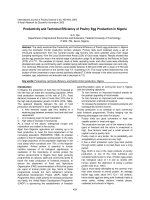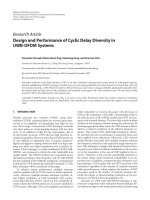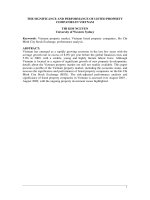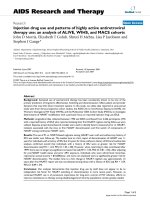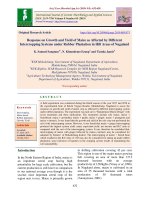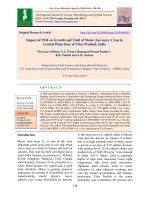Growth and performance of cashew nut production in India - An analysis
Bạn đang xem bản rút gọn của tài liệu. Xem và tải ngay bản đầy đủ của tài liệu tại đây (222.1 KB, 7 trang )
Int.J.Curr.Microbiol.App.Sci (2017) 6(6): 1817-1823
International Journal of Current Microbiology and Applied Sciences
ISSN: 2319-7706 Volume 6 Number 6 (2017) pp. 1817-1823
Journal homepage:
Original Research Article
/>
Growth and Performance of Cashew Nut Production in India- An Analysis
E. Elakkiya1*, P. Sivaraj2 and A. Vijayaprabhakar3
1
Department of Physical Sciences and Information Technology, 2Department of Agricultural
Extension and Rural Sociology, 3Department of Agronomy, Tamil Nadu Agricultural University,
Coimbatore- 641003, Tamil Nadu, India
*Corresponding author
ABSTRACT
Keywords
Cashew nut,
Growth,
Performance,
Statistics and Trend
Article Info
Accepted:
23 May 2017
Available Online:
10 June 2017
Cashew nut attracts the people of all categories and all over the world.
Probable reasons for that it’s pleasant taste and nutritive values. The
farmers perspective cashew nut was cash crop even though dry areas. The
present study aims to access the growth and performance of cashew nut
production in India from 1965-66 to 2014-15. For this study statistics tools
like descriptive statistics and percentage analysis use for interpret data. The
results indicate that increasing trend in production of cashew nut in India.
Introduction
The cashew nut has been introduced into
India in 16th century in order to prevent soil
erosion only. Later the kernels from cashew
nut become a major source of income for
most of the people in coastal tropical regions
of India. India has always been a major player
in the production of cashew.
It is the largest producer, processor, consumer
and exporter of cashew in the world. India led
the production of cashews in 2015-16 with a
crop of 172,719 metric tons (kernel basis),
which represented the 23.00 percent of global
production. In India cashew is being grown in
an area of 10.27 lakh hectares with a total
production of 7.25 lakh MT of raw nuts and
unit area productivity of 706 kg/ha.
According to the estimates by the Directorate
of Cashew nut & Cocoa Development, the
production of raw cashew nuts in India during
2015-2016 was 6,82,000 M T and area of
1035 hectare as against the estimate
production of 7,44,000 M T during 20142015.
The main objective of the paper is highlight
the growth and performance of the cashew nut
production in India and compared with the
large and small sample data during 1965-66 to
2015-16 (large size) and 1990-91 to 2015-16
(small size). The secondary data were
collected from the Directorate of Cashew and
Cocoa Development (www.indiastat.com).
Materials and Methods
The leading cashew nut production state was
selected for the study, based on 1965-66 to
1817
Int.J.Curr.Microbiol.App.Sci (2017) 6(6): 1817-1823
2015-16 yearly data. The purposively to select
first six leading states in cashew nut
production namely Maharashtra, Kerala,
Andhra Pradesh, Orissa, Karnataka and Tamil
Nadu for the study.
the independent variable and the latter is
called the dependent variable. It should
percentage in the direction of independent
variable.
Results and Discussion
Descriptive Statistics
Descriptive statistics for large samples
The branch of statistics is devoted to the
summarization and description of data
(population or sample) is called descriptive
statistics. Descriptive statistics are used to
present quantitative descriptions in a
manageable form. In an agricultural research,
we have lots of measures. It is help us to
simply large amount of data in a sensible way.
Each descriptive statistics reduces lots of data
into a simple summary.
To study the nature of each sequence these
have been exposed to get various statistics.
Descriptive statistics are used to define the
elementary structures of the data in a study.
They provide simple summaries about the
sample and the measures. Together with
simple graphics analysis, they form the basis
of virtually every quantitative analysis of
data. Descriptive statistics are typically
distinguished from inferential statistics. With
descriptive statistics we are simply describing
what is or what the data shows. Statistical
tools used to define the above series are
minimum, maximum, average, standard error,
skewness and kurtosis.
Percentage analysis
Percentage Analysis is applied to create a
contingency table from the frequency
distribution and represent the collected data
for better understanding. Percentage analysis
is the method to represent raw streams of data
as a percentage (a part in 100 - percent) for
better understanding of collected data. If
specify one variable as causing or influencing
a second variable, the first variable is called
Descriptive statistics stated in table 1. The
descriptive statistics demonstrates the mean,
median, standard deviation, maximum and
minimum values along with other statistical
properties. The production of cashew product
shows volatile pattern. There was standard
deviation value of non-zero. The coefficient
of variation was used statistic for comparing
the degree of variation from one data series to
another, even if the means are severely
different from each other. It was calculate as
the ratio of standard deviation to mean. The
coefficient of variation was 57.70 %. Β2
(kurtosis) value (-1.244) of production
indicates there platykurtic in nature. Positive
values of skewness expose that starting from
the initial years of the period under study a
continuous effort was there to increase the
yield of cashew nut. Table 1 shows that the
descriptive statistics for 51 years cashew nut
production in India (i.e. large samples).
Descriptive statistics for small samples
The descriptive statistics demonstrates the
mean, median, standard deviation, maximum
and minimum values along with other
statistical properties. The production of
cashew product shows volatile pattern. There
was standard deviation value of non-zero. The
coefficient of variation is a useful statistic for
comparing the degree of variation from one
data series to another, even if the means are
severely different from each other. It was
calculate the ratio of standard deviation to
mean. The coefficient of variation is 26.84%.
Β2 (kurtosis) value (-1.107) of production
1818
Int.J.Curr.Microbiol.App.Sci (2017) 6(6): 1817-1823
indicates there platykurtic in nature. Positive
values of skewness expose that starting from
the initial years of the period under study a
continuous effort was there to increase the
yield of cashew nut. Table 2 shows that the
descriptive statistics for 51 years cashew nut
production in India (i.e. small samples).
Table.1 Descriptive statistics for cashew nut production in
India for large samples (1965 to 2016)
S. No.
1.
2.
3.
4.
5.
6.
7.
8.
9.
10.
11.
12.
13.
14.
Descriptive statistics
Mean
Standard Error
Median
Standard Deviation
Sample Variance
Coefficient of variation (%)
Kurtosis
Skewness
Range
Minimum
Maximum
Sum
Count
Confidence Level (95.0%)
367.5607843
29.70248238
321.6
212.1181521
44994.11043
57.70
-1.244007266
0.424808435
649.4
103.8
753.2
18745.6
51
59.65919163
Table.2 Descriptive statistics for cashew nut production in
India for small samples (1990 to 2016)
S.No.
1.
2.
3.
4.
5.
6.
7.
8.
9.
10.
11.
12.
13.
14.
Descriptive statistics
Mean
533.448
Standard Error
28.63411958
Median
533.6
Standard Deviation
143.1705979
Sample Variance
20497.8201
Coefficient of variation (%)
26.84
Kurtosis
-1.106674347
Skewness
0.032418559
Range
458.6
Minimum
294.6
Maximum
753.2
Sum
13336.2
Count
25
Confidence Level (95.0%)
59.09791821
1819
Int.J.Curr.Microbiol.App.Sci (2017) 6(6): 1817-1823
Table.3 Cashew nut production in the major producing states in
India during 1995 to 2015 (In Million Tonnes)
Year
1965-66
1966-67
1967-68
1968-69
1969-70
1970-71
1971-72
1972-73
1973-74
1974-75
1975-76
1976-77
1977-78
1978-79
1979-80
1980-81
1981-82
1982-83
1983-84
1984-85
1985-86
1986-87
1987-88
1988-89
1989-90
1990-91
1991-92
1992-93
1993-94
1994-95
1995-96
1996-97
1997-98
1998-99
1999-00
2000-01
2001-02
2002-03
2003-04
2004-05
Maharastra
Kerala
2.7
2.1
2.3
2.4
3.5
3.5
3.8
3.7
3.6
4.2
4.2
4.3
4.8
7.2
6.0
8.0
10.0
10.0
12.4
14.1
15.8
19.1
21.4
24.4
271.1
29.52
31.96
43.75
46.86
37.6
69.0
80.0
60.0
85.0
125.0
98.0
103.0
115.0
120.0
174.0
73.0
81.6
82.6
82.7
83.0
85.4
85.9
86.8
89.8
95.9
107.2
107.5
108.2
110.5
116.0
117.0
118.0
120.9
123.7
126.6
128.9
130.9
134.0
136.9
139.0
142.1
155.5
151.6
140.2
119.2
140.0
134.0
100.0
130.0
100.0
76.0
87.0
94.0
95.0
64.0
Andhra
Pradesh
7.0
7.2
7.9
8.5
9.0
9.0
9.2
10.1
12.0
12.8
12.6
12.5
13.4
14.0
16.0
16.5
20.0
20.0
2.2
24.4
26.8
29.1
31.9
34.3
36.6
37.8
71.2
44.9
46.6
58.7
71.7
60.0
50.0
80.0
100.0
75.0
88.0
98.0
95.0
88.0
Orissa
1.5
1.4
1.4
1.4
1.2
1.3
1.3
1.5
2.0
2.5
3.9
3.9
4.0
4.3
5.0
6.0
8.0
8.5
10.0
11.9
16.9
18.6
22.3
26.8
28.6
29.1
60.1
39.1
43.4
37.2
43.0
40.0
45.0
50.0
40.0
59.0
59.0
55.0
71.0
74.0
1820
Karnataka
6.0
4.6
6.8
7.0
7.5
8.5
9.7
10.5
11.3
12.3
15.2
15.2
15.7
16.0
16.0
16.5
18
19.1
19.1
20.0
20.9
22.0
22.9
23.7
24.7
25.8
74.4
31.3
31.5
26.4
37.6
52.0
35.0
40.0
60.0
42.0
40.0
44.0
46.0
43.0
Tamil
Total
Nadu
production
10.3
103.8
110
213.2
10.8
118.5
11.8
120.4
12.6
123.3
12.5
127.2
12.3
131.0
9.6
129.8
9.0
135.5
8.7
144.3
10.5
161.5
10.2
162.5
10.2
165.3
10.0
171.8
11.0
180.3
11.0
185.3
10.5
195.8
11.3
201.4
11.3
190.9
11.6
221.3
11.8
234.5
11.9
245.6
12.0
260.3
12.4
274.3
12.4
529.6
12.47
294.6
12.71
533.6
19.19
349.2
19.2
348.4
22.0
321.6
30.9
417.8
30.0
430.0
30.0
360.0
35.0
460.0
45.0
520.0
59.0
450.0
46.0
472.0
50.0
506.0
51.0
535.0
53.0
544.0
Int.J.Curr.Microbiol.App.Sci (2017) 6(6): 1817-1823
2005-06
2006-07
2007-08
2008-09
2009-10
2010-11
2011-12
2012-13
2013-14
2014-15
Total
Percent
Rank
Year
1990-91
1991-92
1992-93
1993-94
1994-95
1995-96
1996-97
1997-98
1998-99
1999-00
2000-01
2001-02
2002-03
2003-04
2004-05
2005-06
2006-07
2007-08
2008-09
2009-10
2010-11
2011-12
2012-13
2013-14
2014-15
Total
Percent
Rank
183.0
197.0
210.0
225.0
198.0
208.0
216.0
77.0
236.2
235.0
3668.49
20.308742
II
67.0
72.0
78.0
75.0
76.0
71.0
74.0
0
80.1
80.0
5073.7
28.088
I
92.0
99.0
107.0
112.0
99.0
107.0
113.6
0
100.4
100.0
2397.9
13.2747625
III
78.0
84.0
90.0
95.0
84.0
91.0
96.0
224.6
85.7
85.5
1952.9
10.811245
IV
45.0
52.0
56.0
60.0
53.0
57.0
66.0
0
80.6
80.5
1548.3
8.5713811
V
56.0
60.0
65.0
68.0
60.0
65.0
60.0
12.1
67.4
67.0
1471.67
8.1471578
VI
Table.4 Cashew nut production in the major producing states in
India during 1990 to 2015 (In Million Tonnes)
Tamil
Maharashtra Kerala Andhra Pradesh Orissa Karnataka
Nadu
29.52
142.1
37.8
29.1
25.8
12.47
31.96
155.5
71.2
60.1
74.4
12.71
43.75
151.6
44.9
39.1
31.3
19.19
46.86
140.2
46.6
43.4
31.5
19.2
37.6
119.2
58.7
37.2
26.4
22.0
69.0
140.0
71.7
43.0
37.6
30.9
80.0
134.0
60.0
40.0
52.0
30.0
60.0
100.0
50.0
45.0
35.0
30.0
85.0
130.0
80.0
50.0
40.0
35.0
125.0
100.0
100
40.0
60.0
45.0
98.0
76.0
75.0
59.0
42.0
59.0
103.0
87.0
88.0
59.0
40.0
46.0
115.0
94.0
98.0
55.0
44.0
50.0
120.0
95.0
95.0
71.0
46.0
51.0
174.0
64.0
88.0
74.0
43.0
53.0
183.0
67.0
92.0
78.0
45.0
56.0
197.0
72.0
99.0
84.0
52.0
60.0
210.0
78.0
107
90.0
56.0
65.0
225.0
75.0
112
95.0
60.0
68.0
198.0
76.0
99.0
84.0
53.0
60.0
208.0
71.0
107
91.0
57.0
65.0
216.0
74.0
113.6
96.0
66.0
60.0
77.0
0
0
224.6
0
12.1
236.2
80.1
100.4
85.7
80.6
67.4
235
80.0
100.0
85.5
80.5
67.0
3203.89
2401.7
1994.9
1758.7 1179.1
1095.97
24.02401
18.0089 14.95853392
13.1874 8.8413491 8.2180081
I
II
III
IV
V
VI
1821
573.0
620.0
665.0
695.0
613.0
653.0
725.2
751.7
753.2
744.9
18063.6
Total
production
294.6
533.6
349.2
348.4
321.6
417.8
430.0
360.0
460.0
520.0
450.0
472.0
506.0
535.0
544.0
573.0
620.0
665.0
695.0
613.0
653.0
725.2
751.7
753.2
744.9
13336.2
Int.J.Curr.Microbiol.App.Sci (2017) 6(6): 1817-1823
Comparing with large and small samples
with descriptive statistics
When compared with the large samples and
small samples, it would be moderate different
from the standard error, confidence level,
kurtosis and skewness. Whether highly
different from mean, standard deviation,
sample variance and coefficient of variance.
In the coefficient of variance (CV) was unitfree measure. The CV value would be small if
the variation was small. In small sample has
the less variation. From this study the
consistency of two samples, the small sample
with less coefficient of variation (CV), it
represents to be small sample is more
consistent when compared with large sample.
Percentage analysis
The large samples (i.e. 1965-66 to 2014-15
years) were showed in table 3 and Kerala
state was the leading cashew nut producer
state in India. They produce 28.09 per cent of
total production from India. Maharashtra was
the second largest producer state of cashew
nut in India. They produce 20.31 per cent of
total production followed by Andhra Pradesh,
Orissa, Karnataka and Tamil Nadu are
occupied third, fourth, fifth and sixth largest
producer state of cashew nut in India. They
produce 13.27%, 10.81%, 8.57% and 8.15 per
cent, respectively of total production. Poor
qualities of cashews are grown in some states,
which is due to the natural calamities,
drought, pest and diseases.
The small samples (i.e. 1990-91 to 2014-15
years) as showed in table 4, Maharashtra was
the leading state of cashew nut producer in
India. They produce 24.02 per cent of total
production from India. Kerala was the second
largest producer state of cashew nut in India.
They produce 18.01 per cent of total
production followed by Andhra Pradesh,
Orissa, Karnataka and Tamil Nadu are
occupied third, fourth, fifth and sixth largest
producer state of cashew nut in India. They
produce 14.96%, 13.19%, 8.84% and 8.15 per
cent, respectively of total production. Poor
qualities of cashews are grown in some states,
which is due to the wrong harvesting
techniques.
The results conclude that the cashew nut
production in India was increased during
selected period from 1965-66 to 2014-15. In
small sample have less variation and more
consistent (i.e. less CV value) when compared
with large sample. In large samples, Kerala
state has the largest cashew nut production
during 1965-66 onwards. But the small
samples, Maharashtra state has been largest
cashew nut production around 1990-91 years.
In that year, Kerala has been poor qualities of
cashews. So only the cashew production
would be decreased. But other states (i.e.
Andhra Pradesh, Orissa, Karnataka and Tamil
Nadu) are does not change the position of the
cashew nut production for large and small
samples.
Moreover, from these results lightning call for
policy makers and development departments
to implement suitable programmes to reverse
the scenario so as to build confidence and to
improve status of cashew growers by making
farming as a profitable occupation.
Departments need to make supporting price,
insurance to cashew and subsidies has to be
given to cashew growers in order to sustain
their livelihood security. These supportive
measures taken by the government through
respected and line department people will
help the farmers to get maximum profit from
cashew nut cultivation.
References
Mishra, P., Debnath, M. K., Vishwajith K. P.,
Basavanneppa, B. B., and Sahu, P. K.
2014. Modeling and instability analysis
1822
Int.J.Curr.Microbiol.App.Sci (2017) 6(6): 1817-1823
of rice in India and their yield
sustainability. Indian Journal of
Sciences Research and Technology.
2(5): 73- 81.
Mishra, P., P. K. Sahu, B. S. Dhekale and
Vishwajith K. P. 2015.Modeling and
Forecasting of Wheat in India and Their
Yield Sustainability Indian J Econ
Dev.11 (3): 637-647.
Purna Chandra Padhan. 2012. Application of
ARIMA Model for Forecasting
Agricultural Productivity in India.
Journal of Agriculture & Social
Sciences, Vol. 8, No. 2.
How to cite this article:
Elakkiya, E., P. Sivaraj and Vijaya Prabhakar, A. 2017. Growth and Performance of Cashew
Nut Production in India- An Analysis. Int.J.Curr.Microbiol.App.Sci. 6(6): 1817-1823.
doi: />
1823
